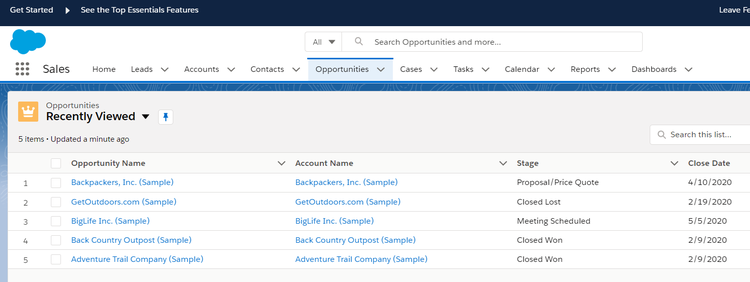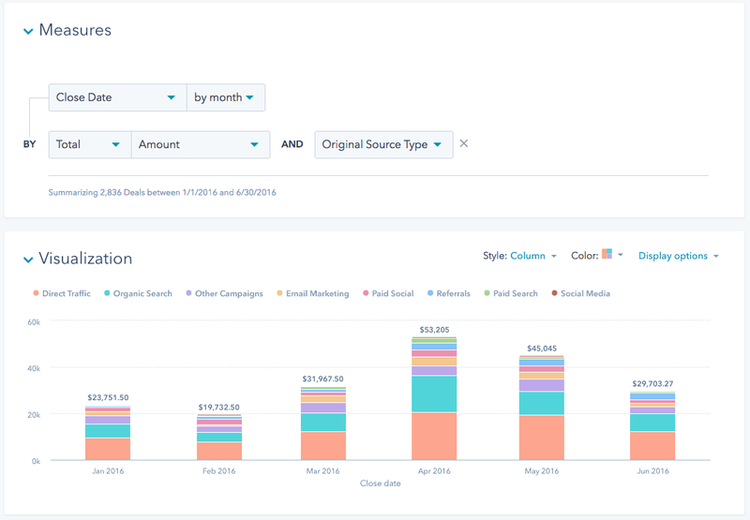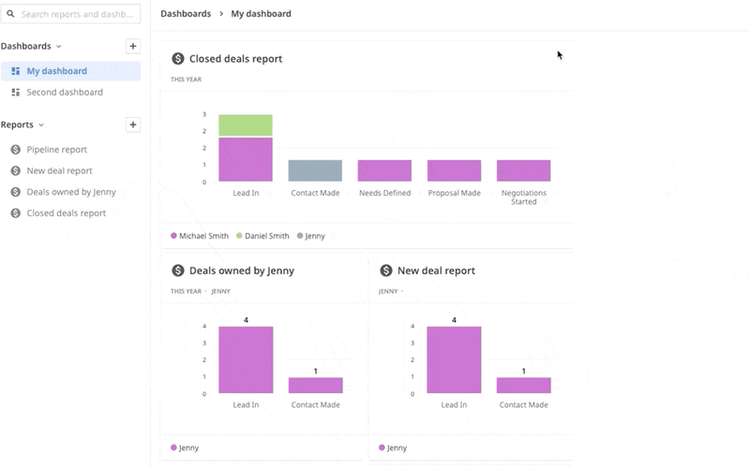When it comes to B2B sales, it can be hard to figure out how to measure sales performance. Is it good enough to just keep an eye on revenue, or could that be hiding trouble down the road that more nuanced sales productivity metrics could sniff out?
In this day and age when data is all around us, you simply must use CRM software and sales tracking software to track key sales metrics. if you don’t, your chances of having a successful sales team are slim.
Tracking the right sales performance metrics will help you spot inefficiencies and identify room for improvement in your team’s ability to close a sale.
If you aren't monitoring the following metrics, you need to start in order to see a boost in revenues throughout the sales cycle over the next quarter.
Overview: What are sales metrics?
Sales metrics refers to the specific numbers and key performance indicators (KPIs) that businesses try to hit in order to meet revenue goals for a period.
Sales team leaders will track these metrics, typically with the help of software, and use them to determine how well their sales team is doing, and whether adjustments should be made to improve performance.
Without tracking sales team metrics such as conversion rate or new prospects, a sales team would have no idea how well it is doing beyond broad numbers such as total revenue, making it difficult to make improvements or do sales forecasting.
Why should your small business track sales metrics?
Sales metrics are important for one very big reason: money. It is impossible, and I do mean impossible, to grow your business without tracking sales metrics.
If you don't know how much time your sales team is spending on a client before closing a sale, what percentage of your leads turn into customers, or what your churn rate is, to name just a few examples, you will have no idea what your team is doing right, or wrong, and therefore no idea how to improve.
Any change you make to grow your business will be a shot in the dark. If you are tracking sales metrics, however, you have a wealth of data to examine that will tell you exactly where you're wasting money and where there are huge opportunities for revenue growth.
The 8 most important sales metrics to track
There are countless sales metrics that you could be tracking, and indeed, which ones you should track really depends on what your goals are. However, every business should be tracking these eight core metrics, so it’s time to start setting up your sales dashboard to do just that.
Metric 1: New leads over
No matter how good your conversion rate is (more on that shortly), if you aren’t getting lots of new leads into the pipeline, your revenues are going to suffer. It’s up to you what time frame you want to track, monthly probably works perfectly fine, but you should be measuring how many leads are coming in on a regular basis.
If you’re struggling to make your revenue goals, explore increasing the amount of leads that are coming into your business by doing more prospect qualifying.
Tips for responding to new leads stats:
When you start crunching the numbers on new leads, you should pay attention to a couple of things in particular.
- Make sure your lead qualification process is airtight: You may be shoving a ton of leads into the pipeline, but if you don’t know how to prospect properly, or if you don’t have the right prospecting tools, you're just wasting your sales team's time, and therefore losing out on revenue. If more leads aren't leading to more sales, review your qualification process.
- Track where they came from: If you get a glut of new leads in the sales pipeline, you need to know their source in order to replicate this the next time period.

Salesforce's software lets you view detailed information about prospects. Image source: Author
Metric 2: Lead response time
You have minutes to contact a lead before your chance of landing a sale drops precipitously. Once that prospect fills out a form or sends you an email in response to an ad, the clock is ticking. By measuring lead response time, you can determine how quickly you are typically getting back to leads.
This metric will give you insight into whether you have room to shorten the lead response time as a way to deal with revenues that are lagging.
Tips for responding to lead response time stats:
When you start crunching the numbers on lead response time, you should pay attention to a couple of things in particular.
- Take steps immediately if the figure comes in high: If you're finding that your sales team isn't responding to a lead until hours or even days later, you need to take steps now to improve the response rate. Create a phone follow-up schedule to improve this figure, and try to make it align with the best times of day and days of the week for follow-ups: mid-week and late afternoon.
- Ensure these are qualified leads: It does no good to scramble to increase your lead response time, only to find that these leads aren't qualified, so review your lead qualification process to ensure that it is sound first. You don't want to put the cart before the horse by prioritizing response time only to find you’re responding to unqualified and low quality leads.
Metric 3: Conversion rate
A salesperson's conversion or close rate is often the metric he or she is most measured against. Basically, it's all the opportunities that were won over a certain period of time.
If a sales team is struggling to achieve revenue goals, one of the first places a manager will look is at the conversion rate. If it's low, that means leads are slipping through their fingers, and it's time to figure out why.
It could be because salespeople just aren't doing a good job closing, or perhaps the prospects weren't properly qualified. Either way, it's a critical sign that something is amiss.
Tips for responding to conversion rate stats:
When you start crunching the numbers on conversion rates, you should pay attention to a couple of things in particular.
- Make adjustments to your close: If your conversion rate is disappointingly low, maybe your sales team isn't using the right close. There are countless different types of closes for many kinds of situations, so try a few different ones and see which one gets the best conversion rate.
- Go back to work on your sales pitch: Another way to boost your conversion rate is to examine whether you're making a convincing value proposal to the client. Try making some tweaks or find ways to add value, and then revisit this stat in a few weeks.

HubSpot's software shows vital conversion stats. Image source: Author
Metric 4: Opportunity win rate
A lot of people confuse conversion rate with this metric, but there is a critical difference. If a salesperson has 100 opportunities, closes 20 of them (win or lose), and scores four sales, that's a conversion rate of 4% (four sales out of 100 opportunities).
The opportunity win rate, however, is more specific: it measures what your success rate was when you went for the kill, and doesn't include opportunities that are still open. So in the above case, the opportunity win rate would be 20% (four sales out of 20 closed opportunities).
Tips for responding to opportunity win rate stats:
When you start crunching the numbers on opportunity win rates, you should pay attention to a couple of things in particular.
- Make the deal time sensitive: A low opportunity win rate has the same cause as a low conversion rate: you just aren't convincing the client that it's time to buy. That could be because you haven't communicated value, but it could also be a lack of urgency. So add some by offering a discount if they buy now, or some other type of limited time offer.
- Make it personal: Yes, raw numbers can be convincing, but sometimes your sales pitch needs a personal story for it to really hit home on how your product or service will help them.
Metric 5: Average deal size
Your team could be closing deals left and right, but if your average deal size is low, you may not hit revenue quotas. It's a simple calculation: you just need to divide the total revenue from deals over a certain period by the total number of deals.
If you're watching this metric, you can see if the deal size is fluctuating which will give you greater insight into your sales operation. You can then make adjustments based on your goals. Perhaps you want a smaller deal size but more customers, or maybe you're gunning for big enterprise contracts that are fewer in number.
Tips for responding to average deal size stats:
When you start crunching the numbers on average deal size, you should pay attention to a couple of things in particular.
- Offer a premium version: You can increase your average deal size simply by offering a few more bells and whistles as part of a "premium" package. This may hurt your sales with the more inexpensive products, but your average deal size will go up.
- Keep an eye on total revenues: While average deal size will increase with a premium version of the product, the total number of sales may decline to a point that it cancels that benefit out.
Metric 6: Customer acquisition cost (CAC)
CAC helps you understand just how much money you spent trying to get that customer, from salesperson time to marketing dollars to anything else that goes into your operation.
Tracking CAC can be very eye opening, particularly if you find that, say, it costs almost as much to acquire a certain type of customer as they bring in with a sale, which might suggest that you should abandon that type of client and spend more time on other more profitable customers.
Tips for responding to CAC stats:
When you start crunching the numbers on CAC, you should pay attention to a couple of things in particular.
- Conduct an expense audit: Find out where you're spending your money. Many businesses don't have a clue. By having an understanding of what you're spending at each step in the sales process, you might be able to spot waste and drive down CAC in the process.
- Offer premium products: This is another spot where boosting average deal size can help you. If you find your CAC is high, raise the value of the customer so it's worth it by offering a higher priced product.
Metric 7: Customer lifetime value (CLV)
While CAC is important, it should be understood in the context of customer lifetime value, or CLV. For example, even if the CAC is high, if that customer buys multiple times over the course of their relationship with the company, that's OK because the customer is extremely valuable as measured by CLV.
You can arrive at CLV by adding up all revenue earned from a customer and subtracting the CAC.
Tips for responding to CLV stats:
When you start crunching the numbers on CLV, you should pay attention to a couple of things in particular.
- Offer a subscription: A customer on a subscription is the gift that keeps on giving, and a low initial purchase of, say, $9.99 can turn into several hundred dollars after a few years.
- Have great customer service: A customer is more likely to buy from you again when they feel they get good customer service, so put some more resources into that and see if it helps your CLV.

Pipedrive tracks customer data in a visual way. Image source: Author
Metric 8: Churn rate
Your CLV stats can get hammered if you have a high churn rate, which refers to the annual percentage rate at which customers abandon your company for whatever reason.
You need to track churn rate to spot any changes in either direction, which can tell you if you need to make adjustments such as more successful client management, offering customer loyalty programs, or simply making the product itself better.
Tips for responding to churn rate stats:
When you start crunching the numbers on churn rate, you should pay attention to a couple of things in particular.
- Educate your customers: Sometimes, a high churn rate comes down to bad relationship management: you convince a customer to buy your product, and they just never quite understand how to use it. Eventually, they lose interest, and you're out a sale. By educating them on, say, how to use that new software you created to help them streamline their IT department, you make them more likely to use it and less likely to return it or abandon it.
- Do a better job at lead qualification: Are you selling to the right customers? Your sales team might be brilliant at getting a client to pull the trigger, but you may end up losing them anyway if you are targeting customers who aren't a good fit for your business. So if your churn rate is high, it may be time to take a look at your qualification process to see if it needs tweaks.
Sales metrics are a big opportunity … with the right tools
The reality is you simply can't miss out on the tremendous opportunities out there to improve your team by closely examining data.
There are so many aspects to sales that are hidden in broad stats like revenues, but if you're tracking the metrics above, you can be sure you won't be caught off guard by a sudden drop in sales, or a sudden, temporary increase that you have no idea how to replicate.
But you need good tools to do this effectively. Try out a few CRM examples to see if they are a fit for your business. By improving your sales management through software, you're more likely to see revenue growth than if you're just winging it based on instinct.
You’ll be able to create a sales metric dashboard that will tell you exactly how your team is performing at any given moment, and that’s vital to future growth.
Our Small Business Expert
We're firm believers in the Golden Rule, which is why editorial opinions are ours alone and have not been previously reviewed, approved, or endorsed by included advertisers. The Ascent, a Motley Fool service, does not cover all offers on the market. The Ascent has a dedicated team of editors and analysts focused on personal finance, and they follow the same set of publishing standards and editorial integrity while maintaining professional separation from the analysts and editors on other Motley Fool brands.